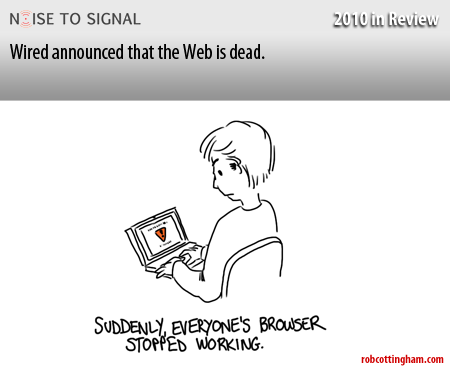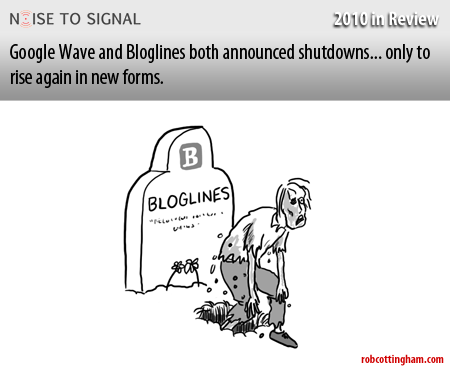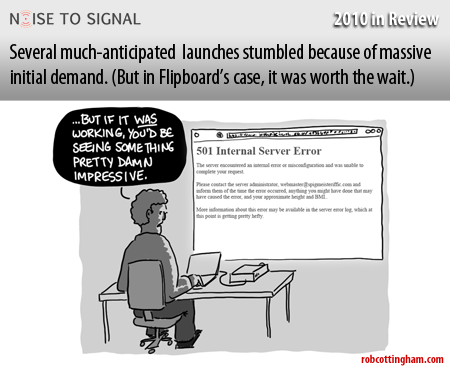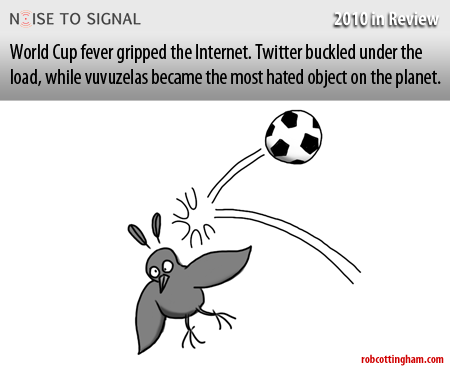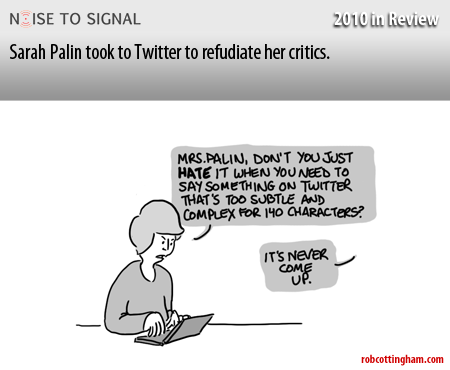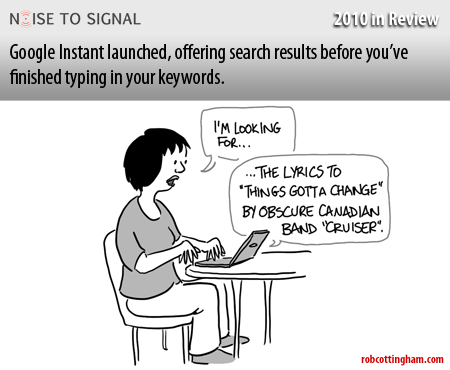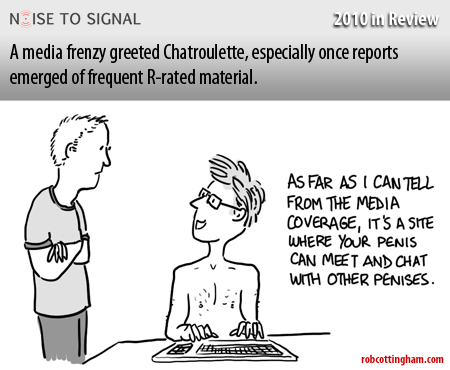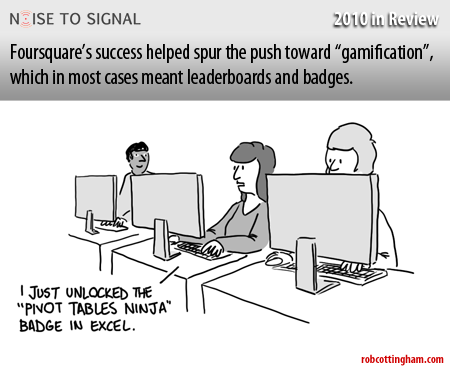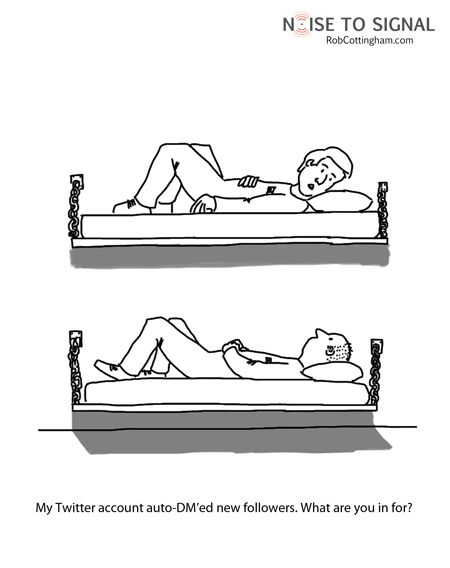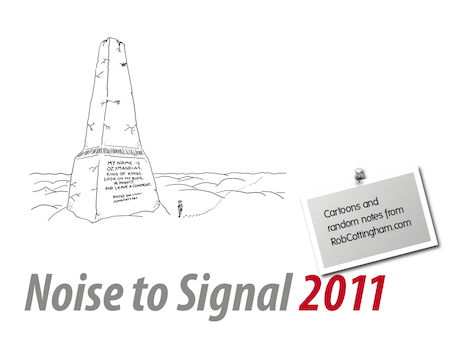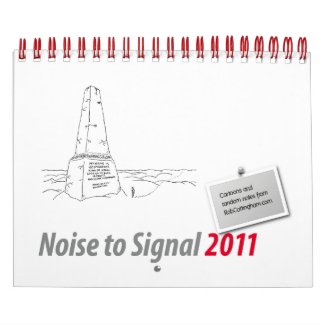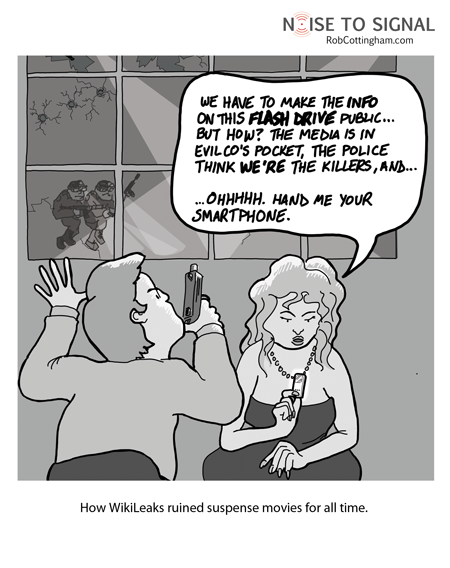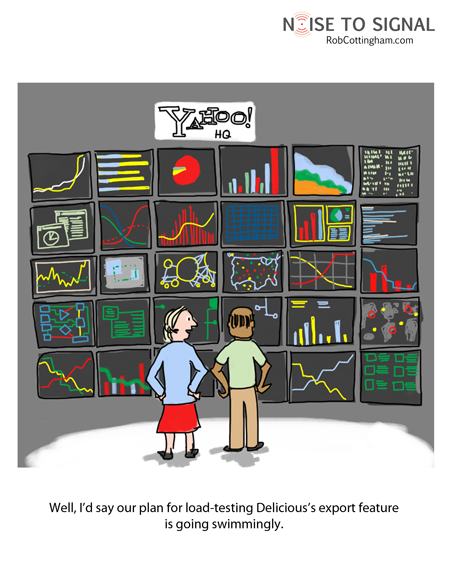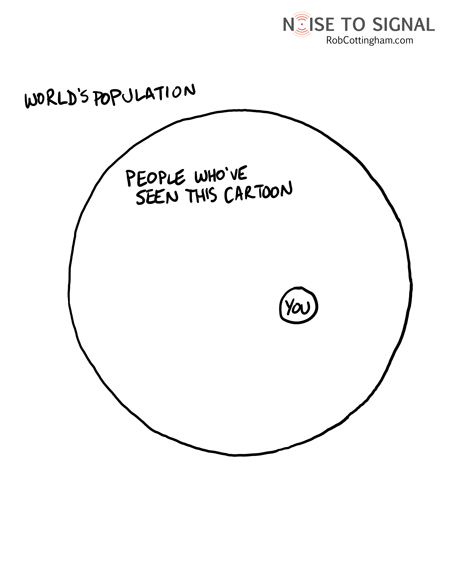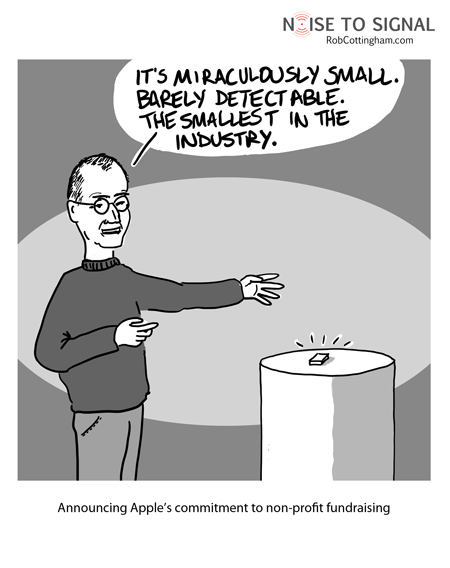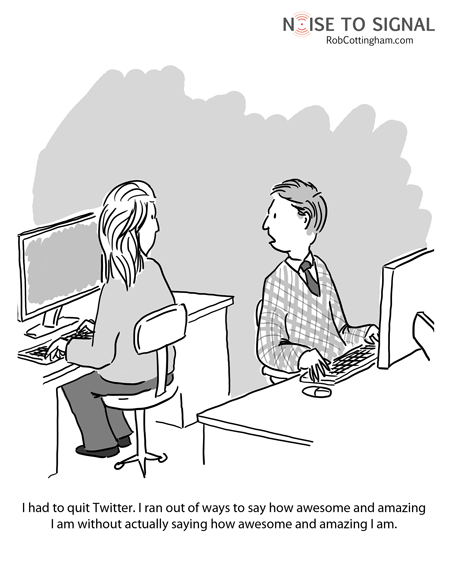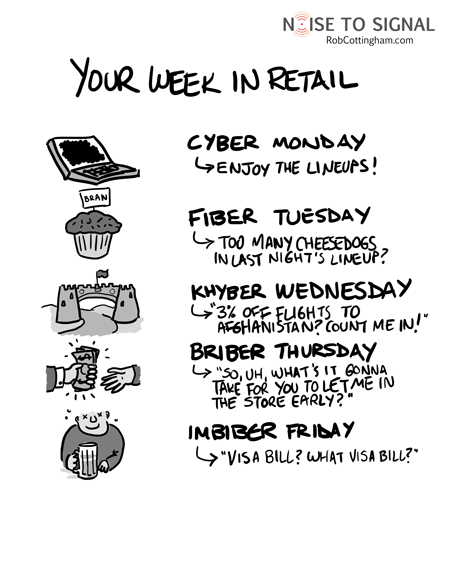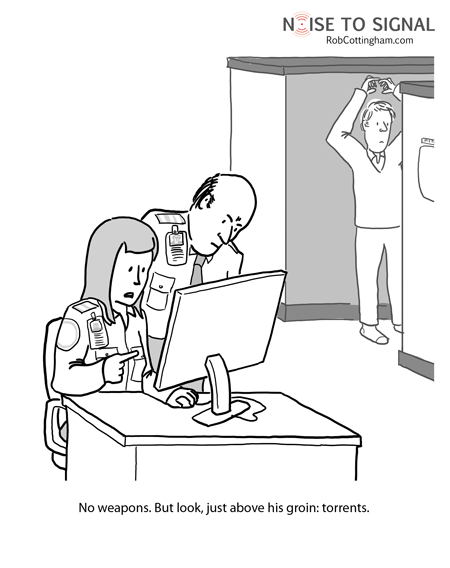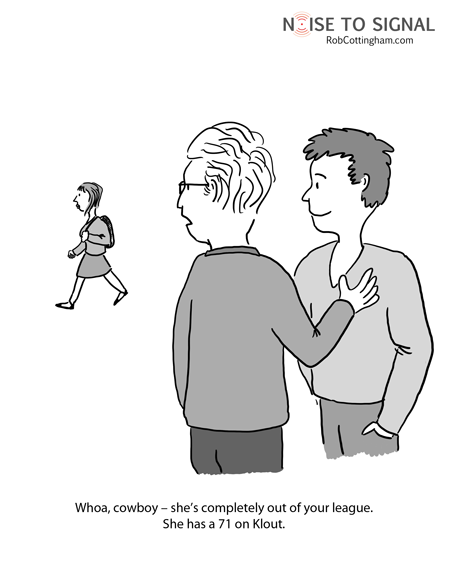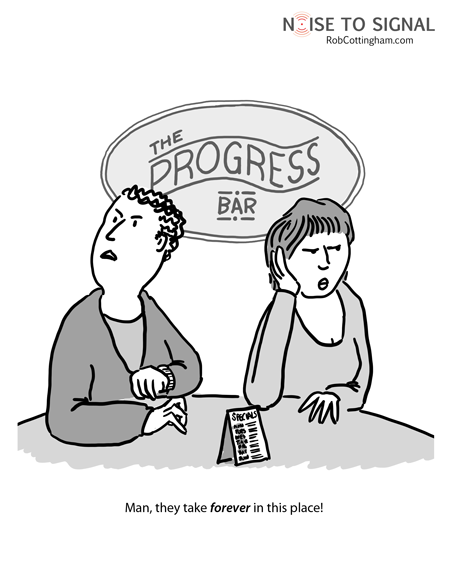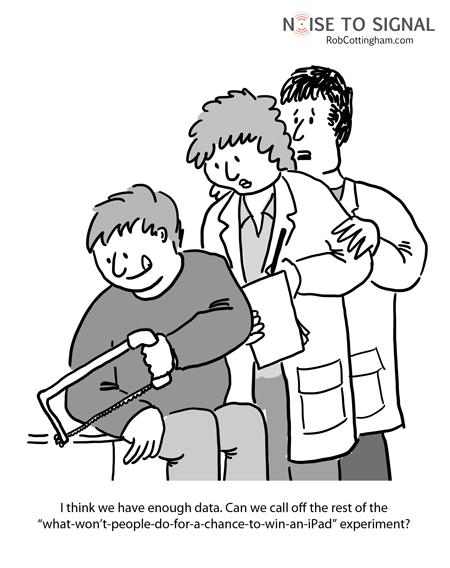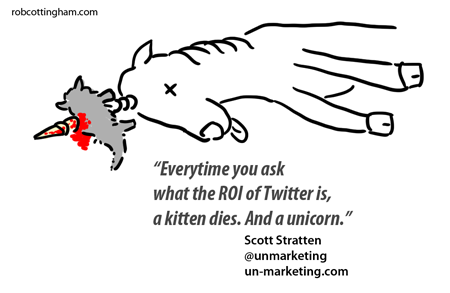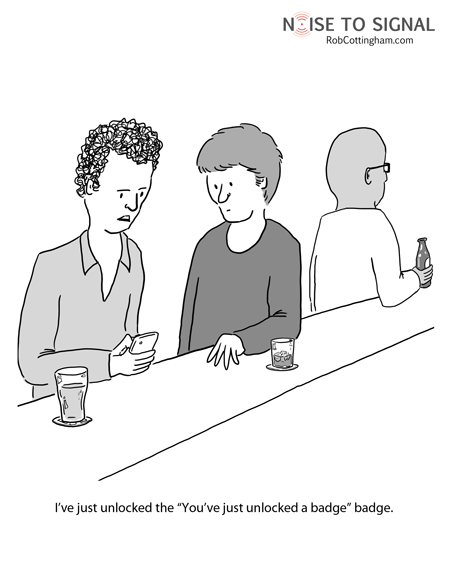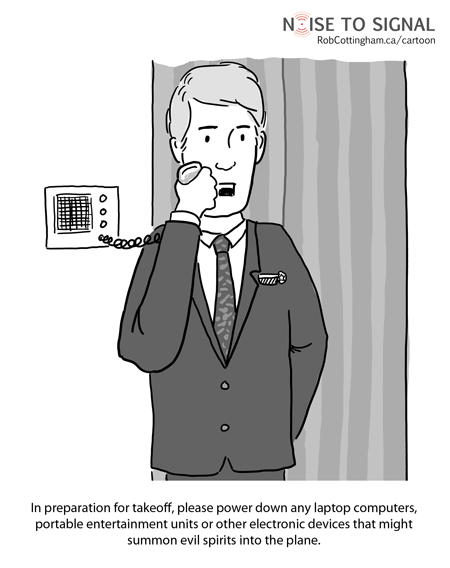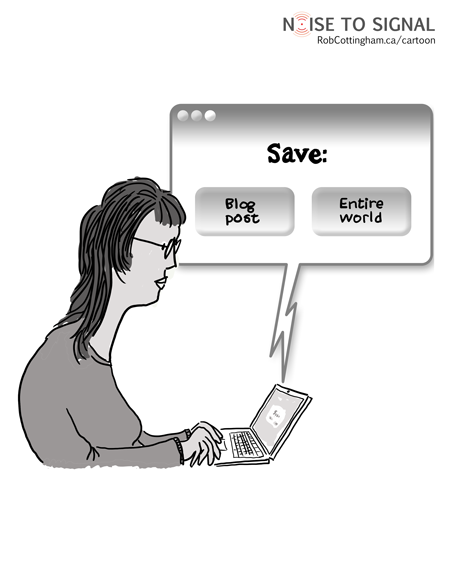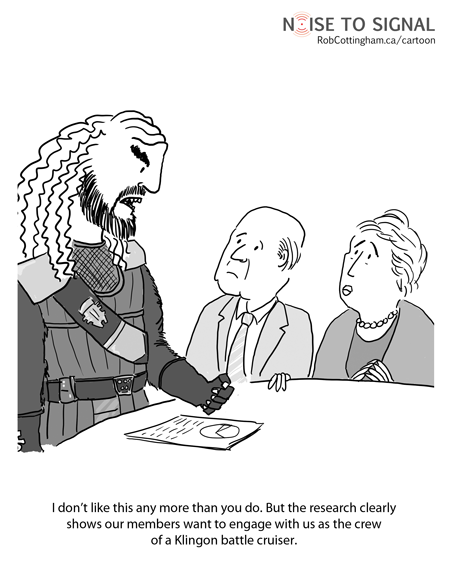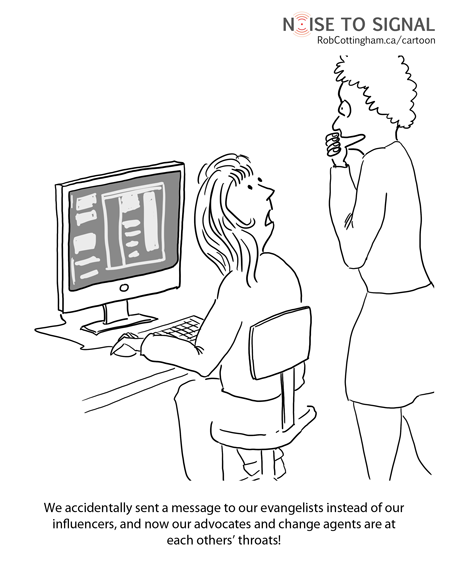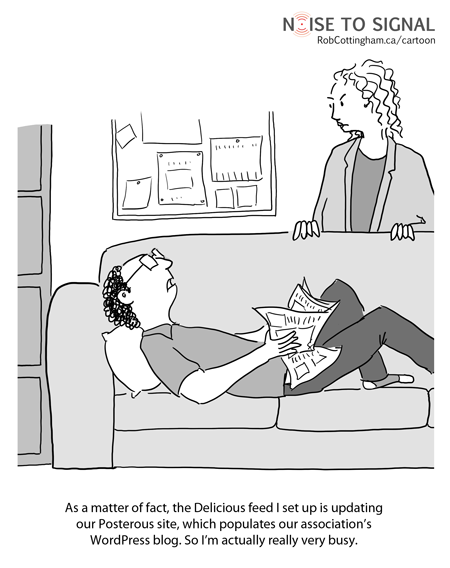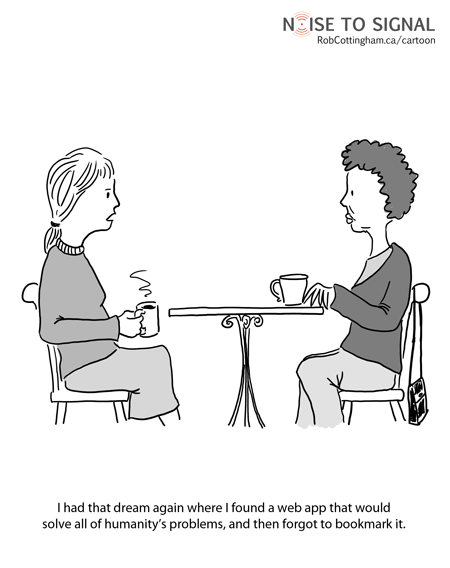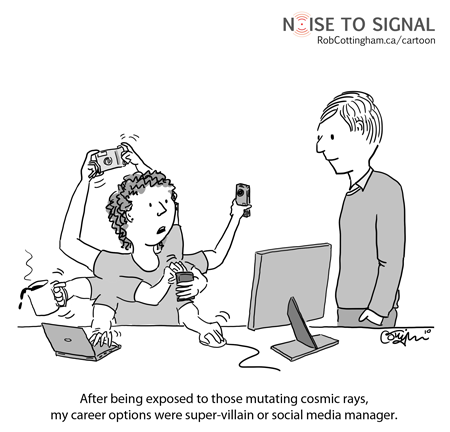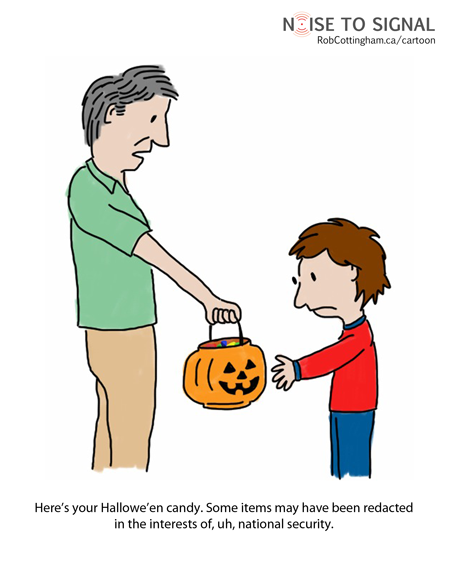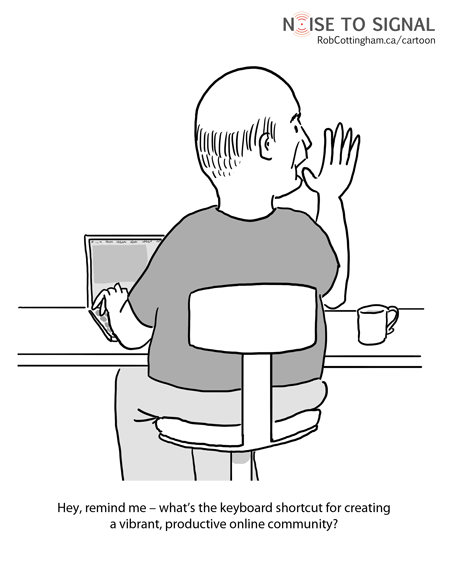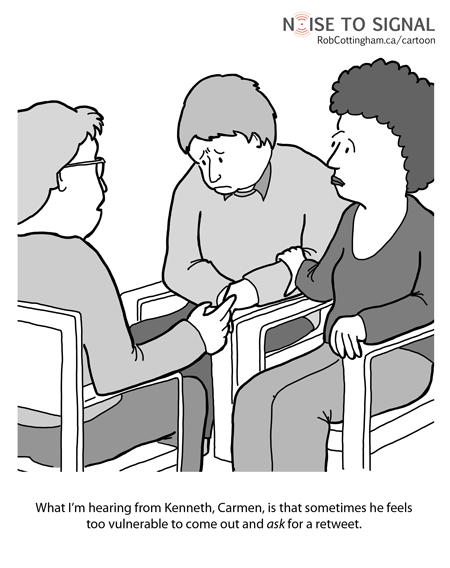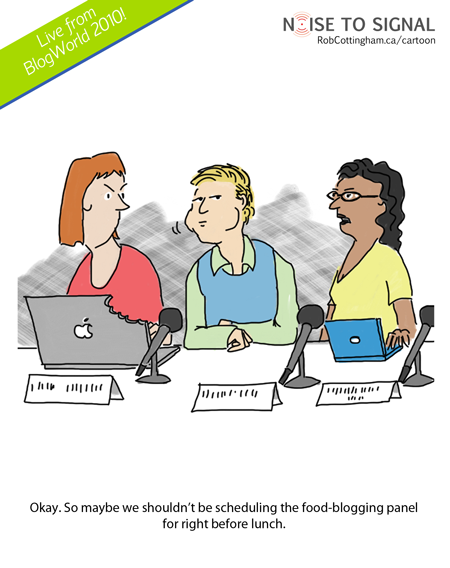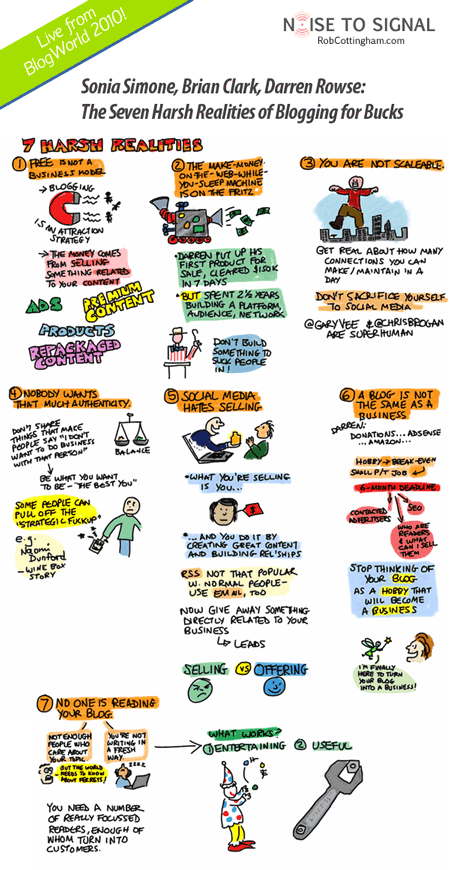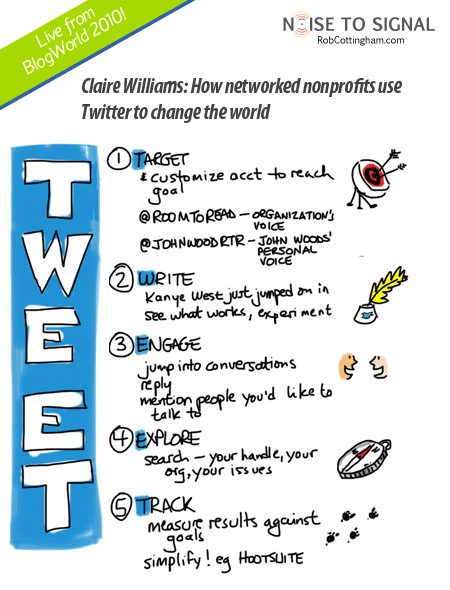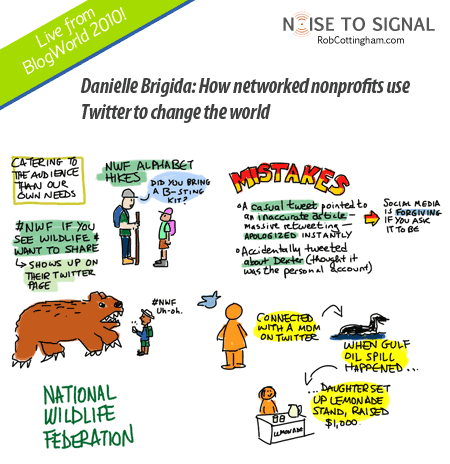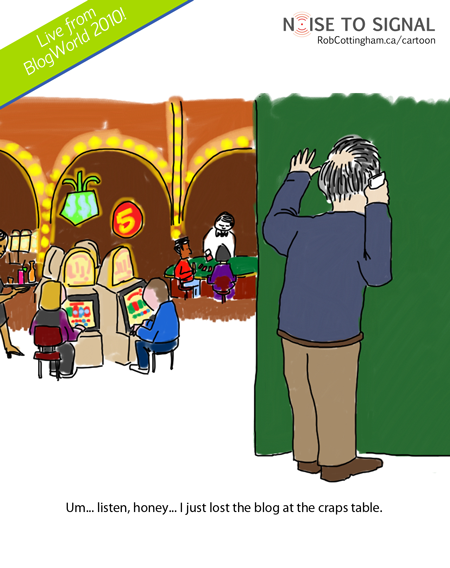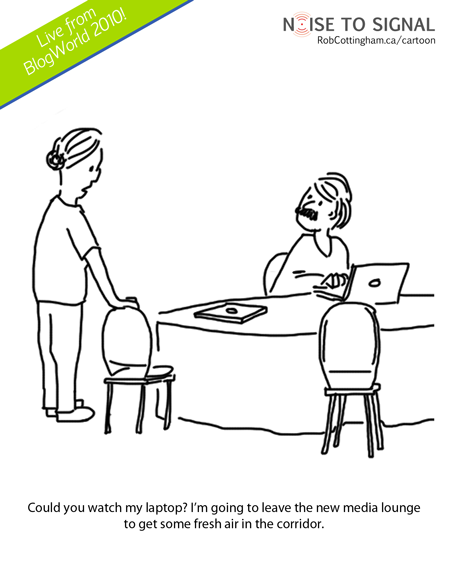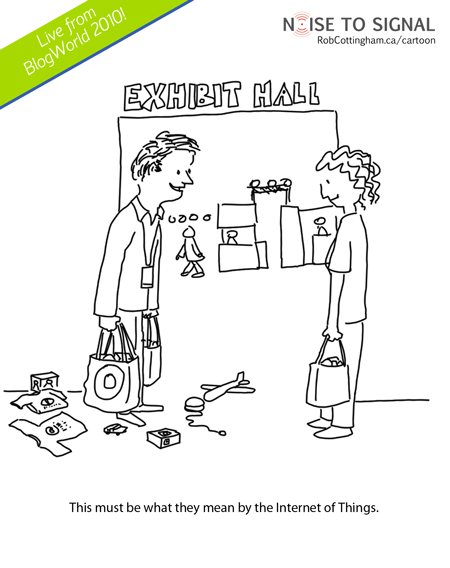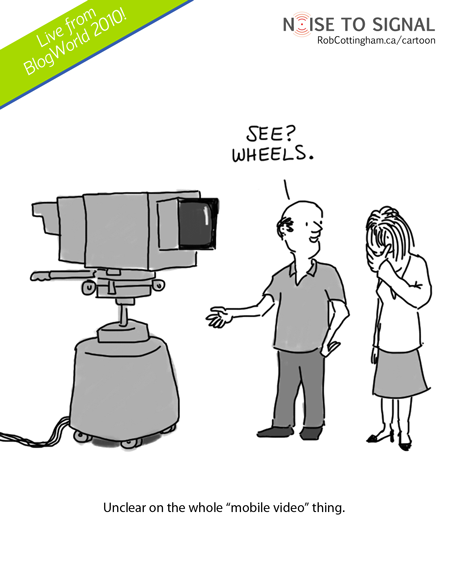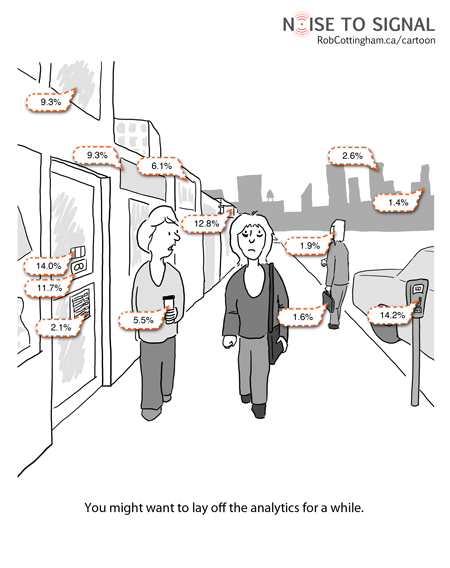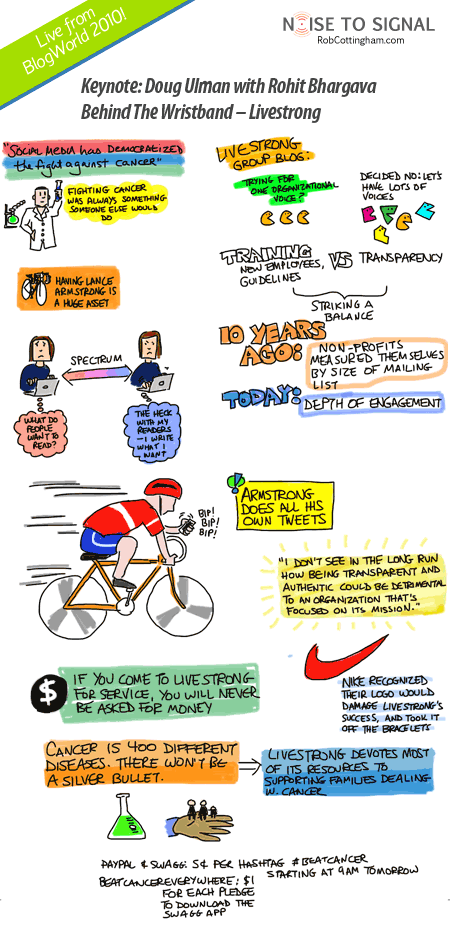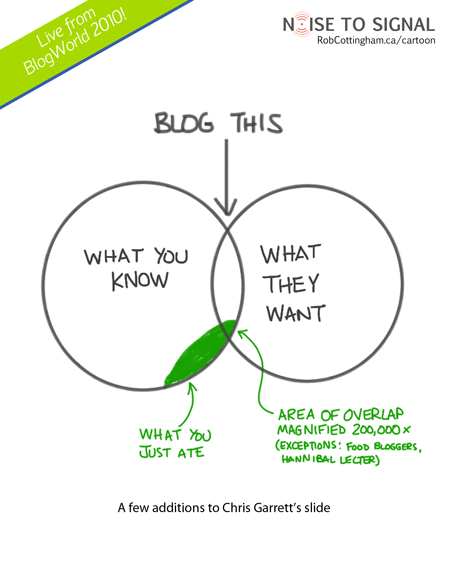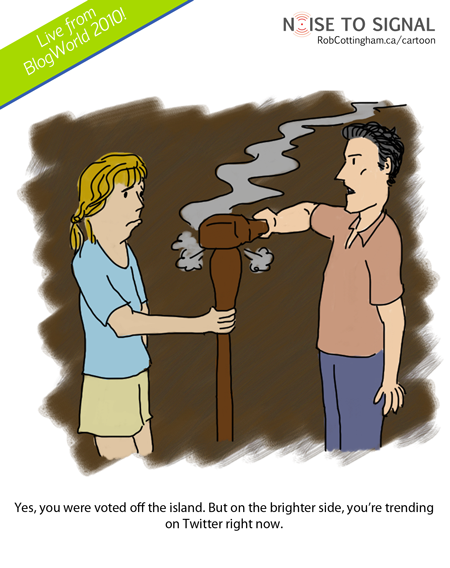Here’s the next cartoon in my retrospective of 2010 in social media. I’ll be posting the individual cartoons all week – but meanwhile, here’s the whole thing in video.
Webcomics from Noise to Signal
2010 in review: You say goodbye, and I say hello
Here’s the next cartoon in my retrospective of 2010 in social media. I’ll be posting the individual cartoons all week – but meanwhile, here’s the whole thing in video.
2010 in review: Hiccups
Here’s the next cartoon in my retrospective of 2010 in social media. I’ll be posting the individual cartoons all week – but meanwhile, here’s the whole thing in video.
2010 in review: World Cup
Here’s the next cartoon in my retrospective of 2010 in social media. I’ll be posting the individual cartoons all week – but meanwhile, here’s the whole thing in video.
2010 in review: Palination
Here’s the next cartoon in my retrospective of 2010 in social media. I’ll be posting the individual cartoons all week – but meanwhile, here’s the whole thing in video.
2010 in review: Google Instant
Here’s the next cartoon in my retrospective of 2010 in social media. I’ll be posting the individual cartoons all week – but meanwhile, here’s the whole thing in video.
2010 in review: Chatroulette
Here’s the next cartoon in my retrospective of 2010 in social media. Chatroulette was an object lesson in not believing media hype about the Next Big Thing. (It’s also a pretty interesting experiment.)
2010 in review: Gamification
In these early days of 2011, I’m going to be posting my cartoon retrospective of 2010 in social media. Buckle up – that’s 14 cartoons headed your way in the next few days!
140 characters without possibility of parole
As 2010 dies down, a lot of us are looking back over the past year. This cartoon was inspired – indirectly – by one of the year’s less-reported stories: the collision between the informal, off-the-cuff culture of Twitter and the rigid world of law. That conflict runs the gamut from totalitarian regimes to liberal democracies:
- In China, Cheng Jianping’s mildly ironic tweet earned her a year in re-education camp.
- In the United Kingdom, Paul Chambers’ frustration at an airport closure led him to tweet a joking threat to blow it up – culminating in a conviction and a £1,000-fine under Britain’s Communications Act 2003.
True, China has long repressed dissent – often brutally – and airports around the world are notorious for frowning on even casual jokes about explosives, violence or hijacking. But Twitter brings a new combination of persistence, reach and spontaneity that we haven’t really grappled with yet.
No matter which you think needs to adapt more – the law, or the way we use social media – we enter 2011 facing a new level of accountability for our spontaneous comments. And the kind of idle conversation that could pass without comment in a pub is now part of the permanent, searchable record.
By the way, this cartoon is part of a 2010 year-in-review I’m putting together. Look for it later this week… and in the meantime, remember to get your Noise to Signal 2011 wall calendar, free for the downloading. Happy holidays!
Noise to Signal’s gift for you
Introducing the 2011 Noise to Signal calendar!
This is for everyone:
- who encouraged me to create a Noise to Signal calendar, or
- who needs a calendar of their own, or
- who is about to walk into an office gift exchange party empty-handed, and desperately needs something.
It’s a free downloadable PDF. So just print that puppy out double-sided, then take it to your corner print shop and ask them to spiral-bind it, and my friend, you have a wall calendar. Update: Okay, let’s have some fun. Share a picture of the calendar hanging on your wall, and you could score a signed cartoon print! The details.
Here’s the download link (PDF, 10 MB). (If you’re sharing it – and I hope you will! – please link to this post rather than the PDF itself. Thanks!)
I’ve also posted it on SlideShare:
If you don’t have the time or means to print it out, and don’t mind waiting for shipping, I’ve also created a version on the Zazzle store:
Thanks for all the support and kind words over the year. And happy holidays from Noise to Signal!
(By the way, I discovered while I was making this that there’s a real shortage of decent-looking free calendar templates out there. So while the calendar as a whole is Creative Commons licensed, I’m releasing the actual calendar grids into the public domain.)
Updated with shameless bragging: This just in – Last night, SlideShare made the calendar its Presentation of the Day. And then a few minutes ago, this email came in:
“A free cartoon calendar for 2011” is being talked about on Facebook more than anything else on SlideShare right now. So we’ve put it on the homepage of SlideShare.net (in the “Hot on Facebook” section).
Well done!
– SlideShare Team
And if you’re enjoying looking forward to 2011, maybe you might like taking a look back at 2010:
The Bourne Connectivity
This one came to me while I was watching an episode of Burn Notice (please hold your applause until the end of the post), where Michael, Fiona, Sam and Jesse have realized they have a piece of unspeakably important information in their hands. And maybe a decade ago, I would have found their dilemma compelling.
But today? In a few minutes, they could post it to Tumblr, Posterous, WordPress, 4chan and – just for the hell of it – Plenty of Fish, with plenty of time left over for Michael and Fiona to agonize over their relationship, for Sam and Fiona to explore their rivalry for Michael’s attention (I suspect they each had emotionally distant parents), and for Michael and Jesse to finally acknowledge the sexual tension between them.
It’s possible I’m overreaching. That may have to be a two-parter.
My point is this: time was when a screenwriter’s greatest enemies were the studio system, writer’s block and, well, other screenwriters. But now writers working in the action/adventure/suspense/blowing-stuff-up genre also have to contrive ways to deprive a character of connectivity.
So to the action movie clichés of which wire to cut and cars slamming into fruit carts, you can soon add batteries running low, cell phone jammers, and “Why did I choose AT&T?”
Delicious: and we all helped!
Maybe this is why they let rumours swirl for a day before announcing they’re trying to find a home for it.
Although, as Alex says, that could be along the same lines as your parents saying “We send Scruffy to live on a nice farm…”
True just by looking at it
So… was it false before you saw it? Discuss.
Left parenthesis, hyphen, colon
Originally posted on ReadWriteWeb.
So now I know. And I have to live with the knowledge.
I’m married to someone who… (okay, deep breaths; bring down the pulse)… who keys in smileys… without a hyphen.
Ten years of marriage, and it’s only yesterday that I discover Alex is perfectly willing to deprive her emoticon-people of a critical facial feature. “A smiley? Really? Exactly how freakin’ happy are they going to be without a nose?!”
Maybe we’ll move past this somehow, and one day we’ll move from :-( to :-) again. Maybe.
…Hey, wait a minute – losing the hyphen gains me an extra character in Twitter, doesn’t it?
Awesome. Marriage saved. :)
(N.B.: Today’s cartoon is inspired in large part by my seven-year-old daughter, who’s been drawing these amazing people with smileys as faces. Props, Li’l Sweetie.)
Non-profit giving: is there an app for that?
(My thanks to Beth Kanter for spurring this cartoon and post!)
If you think of Apple, you may well think of great design, fantastic usability, innovation and just plain coolness. But one thing you probably don’t think of is philanthropy.
Steve Jobs and Apple have come under frequent fire for a lack of visible generosity in charitable contributions. But let’s leave the debate over whether their reputation is well-deserved or not for another time. (“Dammit, Rob, they gave the world the one-button mouse – isn’t that enough?!”)
Instead, let’s talk about Apple’s less-than-open attitude toward charitable giving on the iPhone. (Can I call it iPhilanthropy? No?)
You would think that charitable giving would be a no-brainer. A built-in payment mechanism, beautifully simple UI, countless ways to creatively employ things like location… it should add up to a huge leap forward for non-profits hoping to raise funds.
But before an app can raise any money, it has to clear a hurdle: the iPhone App Store. Only approved applications can make it onto iPhones (at least, the ones that haven’t been jailbroken), and approval hasn’t been forthcoming for charitable apps. The restrictions on just what kind of pitch you can make, and how, are remarkable.
You can’t promise to do anything outside the app itself (as an organization that promised to plant a tree for every app they sold discovered). And you can’t have in-app donations… so there goes nearly all of the benefit of using the iPhone for fundraising. The 30-per-cent cut Apple takes from any transaction through the store is just the coup de grace in deterring iPhone-enabled donations.
Non-profit tech visionary Beth Kanter has taken up the cause of convincing Apple to change its tune. (She’s also announced her intention to bail on her iPhone once the contract expires, and make the jump to Google Android, if things don’t change.) An online petition backing that position has already garnered more than 1,300 signatures.
In fairness to Apple, the company wants to ensure its customers don’t get scammed. But as developer Jake Shapiro pointed out in June, “The excuse that ‘Apple doesn’t want to be held responsible for ensuring that the charitable funds make it to the final destination‘ is a cop-out. Google Grants has tackled this already, and organizations like TechSoup and Guidestar do a sophisticated job of authenticating nonprofits and charities worldwide. Apple, of all companies, can’t credibly say it’s not up to the technical and logistical challenge.”
Apple is, after all, the company of cool… and what’s more, the company of helping people do amazing things with extraordinary tools. Imagine if making charitable giving possible was just their first step… and if Apple brought the same degree of imagination and brilliance that gave us the simplicity and power of OS X, iMovie and iOS to bear on philanthropy.
Conspicuous Me
Originally posted on ReadWriteWeb
I can directly thank two people for today’s cartoon. One is Deb Ng, who tweeted this a few days ago:
If I were to propose a day where no one tweeted links to their own stuff, would you laugh at me, or think “hmmm. That’s a good idea?”
And the other is my wife and Social Signal partner, Alexandra Samuel, whose take on those tweetswas:
I’m in an exotic location, contributing brilliant, world-changing insights to a conversation among important, influential people.
No question, there’s a lot of “Look at me, look at me!” on Twitter. It ranges from the routine status updates that are the meat-and-potatoes of dismissive media coverage of Twitter (“That last burrito isn’t sitting too well”), to the kind of self-promotion that can land you a front-page slot on Tweeting Too Hard.
But take a closer look at Tweeting Too Hard. Most of the tweets on the front page aren’t just expressions of self-absorbed vanity – they’re over-the-top parodies of self-absorbed vanity. They’re deliberately produced entertainment.
And while I see a lot of tweets that read like cries for help from people who couldn’t get their parents’ attention when they were kids, I also see plenty that alert me to the fact that the writer actually has created or shared something brilliant. Or wonderful. Or just worthwhile.
Sometimes self-aggrandizing is in the eye of the beholder. I certainly hope so; I do more than my share of come-look-at-the-thing-I-just-posted tweeting. And Alex ultimately revisited the scolding tone of some of her tweets.
Maybe what’s really in order is a penetrating emotional inventory of the needs and motivations behind our self-focused conversations, about once every month or so. (Those of you who meditate regularly may increase the dosage.) Are we aiming to share something worthwhile, or just bask in a little adulation? And at the end of the day, have we contributed something meaningful to the conversation?
That said, I think Deb’s prescription is worth considering. A regular break from linking to our own stuff could be a healthy way to step back from the brink of becoming the Me Channel… not to mention an impetus to finding other voices and creations worth sharing. Or even reaching for the “@” key now and again.
Just another Cyber Monday
Enjoy!
What they’re really looking for
Originally published on ReadWriteWeb
You may have noticed the home pages of your favourite torrent-tracking sites look a little different today: fewer search fields and options than you’re used to, and maybe a few more U.S. Department of Homeland Security crests and seizure notices than before.
I for one had no idea that the same superagency charged with keeping American skies free from explosive devices was also responsible for keeping American hard drives free from bootleg copies of Cats & Dogs: The Revenge of Kitty Galore. (To the movie and recording industries, I’m sure that seems entirely appropriate – their only misgiving being that DMCA violations aren’t punishable with extraordinary rendition.)
The whole idea behind the DHS was to break down siloing and integrate security efforts. Reviews of the agency’s success on that count have been mixed. But maybe we should be careful what we wish for…
I’m just a 34 dressed up as a 68
Klout is an intriguing service, one that aims to measure your influence on Twitter (and now on Facebook). It’s admittedly far from perfect; “I can get people to retweet things” is pretty minor influence compared to “I can get people to consider certain ideas” or “I can sway people’s voting habits”. But until the Twitter API is hooked up to some of the machinery from Inception – or unless you’re willing to pay for some far more intensive and probably more manual analysis – we work with what we have.
And if you take “influence” to mean “reach of voice” or “ability to direct others’ attention at least for a moment”, then Klout (and cousins like Twinfluence, Twitalyzer, Tweetlevel and my very own Influ-a-rama-matic – what it lacks in reliability it makes up for in ego-boosting) can be pretty useful. Just remember it’s a starting point… and that the raw Klout score is a pretty blunt instrument. (“How influential are you?” “64.”) Diving in and looking at some of the more detailed metrics can take you further, and tell you, for instance, that person x has a lot of followers but doesn’t often engage them, while person y has a smaller audience but much more vigorous engagement.
Even then, though, you’ll need to figure out for yourself what subjects they’re most “influential” on, and with whom. (Klout takes a stab at it with a topic summary at the bottom of each profile, and it’s not a bad starting point. Also, I had no idea that Alex was so influential about the Vancouver Canucks.)
So why, then, do I check Klout obsessively?
- Badges. They have badges.
- To make up for what happened in high school. (Yes, I know.) Dammit, people do love me, and I can quantify it.
- Badges and personal validation… do I really need a third reason?
Please wait for cartoon to load (55%…60%…65%….)
(Originally posted on ReadWriteWeb)
This week’s cartoon is inspired by working at a lot of cafés this week – cafés with very… slow… Wi-Fi.
I’m finding that decent broadband is common enough these days to make slower connections feel extra frustrating. I’m used to being able to download hundred-megabyte software upgrades in the time it takes the barista to pull shots for my Americano. And I’ve grown accustomed to genuinely streaming video; I’ll grind my molars to powder if that TED talk on the Western world’s addiction to speed has to pause for a few seconds midway through to buffer.
The folks at Angus Reid Public Opinion actually released a study back in June suggesting the majority of high-school and post-secondary students suffer stress because of sluggish computers. So I’m clearly not the only one.
Which is why I wish I could drop by the joint depicted below and knock back one of their signature cocktails, the Spinning Beachball. (Depending on your OS, you could also get straight vodka, served in an hourglass.) Their motto could be “Get loaded while you’re loading.”
Got a cocktail recipe of your own?
Want.
Originally posted on ReadWriteWeb.
There’s something about Apple’s consumer design chops that makes their latest product – whatever it happens to be – the definitive object of desire of the moment.
Steve Jobs could announce a new line of refrigerator expansion valves next week, and we’d be lining up at midnight to buy them. (“It’s tiny. It’s revolutionary. It will completely transform the way you lower the temperature of food.”)
And not because we’re slavish Mac fangirls-and-boys. (Okay, not just because of that.) It actuallywill be freakin’ amazing. Sure, you’ll only be able to buy food approved by the App(etizer) Store, but the design! The user experience! the way the mustard swishes out of the way when you swipe!
And before Jobs even leaves the stage, the marketing and promotion industry steps in. The low-end version of the product – whatever the equivalent of an iPod Shuffle is – becomes the giveaway of choice to people signing up for a new service, whether it’s a bank account, cable or a loan-shark arrangement. The high-end version becomes either the first prize for every contest around, or the bait for a multitude of online scams. (Suuuuure people are auctioning iPads off for $2 each.)
Somehow, Apple has found the combination to the Oh God I Have to Have That center of our brains. And if that sounds a little terrifying, it probably is. The only comfort is this: they haven’t quite perfected it yet.
Endangered species and @unmarketing
This is the part of my toonblog from Scott Stratten’s BlogWorld keynote that keeps getting mentioned by people, so I thought I’d offer it on its own after seeing Scott’s tweet yesterday.
Updated: A few thoughts about poor, maligned and misused ROI. Or, Seven Things (Off the Top Of My Head) That I Believe:
- I believe in measuring, benchmarking, testing, comparing and assessing. I believe in doing your best to surface the tangible financial results from an organization’s investments in any field, including social media. But…
- I believe it’s easy to confuse that which can be measured with that which matters… and that, when you’re dealing with human relationships, there’s a lot that both matters tremendously and resists simple measurement. (See also “Schools, Standardized testing”.) But…
- I believe that Belief #2 isn’t a reason not to try. Social media isn’t free, and any responsible communicator wants to use their organization’s resources to maximum effect. But…
- It is a reason to keep your attempts to measure outcomes in some perspective. And…
- It’s a reason not to get so hung up on quantitative data that you miss out on the qualitative benefits of having decent, respectful relationships with people – online and offline. Or that you wind up sounding less like a human being than a not-terribly-clever marketing algorithm.
- I believe there are very smart people who’ve thought about this more than I have.
- I believe it’s time for tea.
Apparently, we DO need these stinking badges
Originally posted on ReadWriteWeb
I’m suddenly seeing badges everywhere.
Location-aware apps like Foursquare and Gowalla award them for things like visiting more than four venues in one night (the “crunked” badge) or checking into the kind of venue known for a particular personality type (the “douchebag” badge).
And now I’m getting badges in nearly every game and entertainment app I use, often with oddly low standards and notifications like “Award: Launching-the-App-for-the-First-Time Badge!”
This goes back – as all good things do – to video games; badges act like little food pellets that help keep you motivated in between levelling up and winning extra lives.
But there’s no question they work, so don’t be surprised when they start popping up in more mainstream applications. The Inbox Zero merit badge could well be built into the next version of Outlook; PowerPoint users (at least the ones I’ve been seeing lately) could be unlocking the “20 bullet points and 16 fonts in one slide!” badge.
Those badges seem to fill some deep-seated craving from our inner Brownies and Cub Scouts. All that’s missing is a proud virtual parent to sew them onto a digital sash for us… and I’m pretty sure that’s coming, too.
MacBook (Not) Air
Originally published on ReadWriteWeb
Fly any airline and you’ll see two parallel rituals being conducted just before takeoff: flight attendants politely reminding passengers to switch off everything remotely entertaining for their own safety, and a subset of the passengers covertly eking out every last second of keyboarding they can before they get caught.
For some of those passengers, the lack of compliance stems from an innate need to defy any authority; for others, a neurotic fear of even a nanosecond of unavoidable disconnection. And for still others, it comes from deep-seated skepticism that 21st-century airline avionics are really all that vulnerable to a few stray processor cycles and rogue oscillations.
I could easily see myself with a foot in each of those camps. (I’d need to graft on a whole new foot to achieve that, but work with me on this.) And yet…
See, here’s the thing. I know (roughly) the physics that keeps a multi-ton steel behemoth aloft. I know the huge amounts invested in the care and maintenance of its systems. I’ve flown countless times.
Yet to some prehistoric part of my brain, it still seems like a complete freaking miracle to me that those wheels actually do leave the tarmac for any significant length of time. And to keep that miracle happening long enough to get us to a safe cruising altitude, my inner awestruck Neanderthal is happy to switch off whatever gizmo it takes: iPad, Kindle, pacemaker… just name it.
But that’s me. When it comes to switching off before taking off, where do you land?
Dialog box
Open Community is a terrific new book from Lindy Dreyer and Maddie Grant for associations that want to dive into the world of online community – and it includes cartoons from yours truly. To celebrate its launch, I’m running a new cartoon from the book every day this week.
Here’s the final cartoon from Open Community – I hope you’ve enjoyed the series, and I hope you’ll check out Maddie and Lindy’s book!
I kind of like that there isn’t an obvious joke behind this one, and that it’s a little ambiguous. Maybe it’s about the choice we all have to write just another blog post, or to try to do something extraordinary – something that could maybe change the world in some small way. Or maybe it’s about unrealistic expectations. Or maybe it’s a remarkably subtle commentary on interface design.
nptrek
Open Community is a terrific new book from Lindy Dreyer and Maddie Grant for associations that want to dive into the world of online community – and it includes cartoons from yours truly. To celebrate its launch, I’m running a new cartoon from the book every day this week.
“This above all, to thine own self be true,” said Polonius… shortly before winding up skewered by one Prince Hamlet in the arras, prompting centuries of snickering by high school students. (Funny thing: Mr. To-Thine-Own-Self died because of concealment and mistaken identity; a little transparency on his part could have made a big difference.)
But for organizations that want to engage with their audiences all Wikinomics-like, how to be true to yourself isn’t necessarily obvious. How do you maintain an authentic identity while releasing significant control to your members and supporters? Where’s the line between openness and allowing your supporters to define you and your mission?
The answer will vary – dramatically – from organization to organization. The important thing is to know going in where your line is… so you don’t wind up trying to be somebody you’re not. As countless family sitcoms have taught us, that may be a road to zany complications, but it won’t lead to authentic relationships.
Q’apla!
(Baffled by the title? Find out about the nptech tag here.)
Po-tay-to, po-tah-to
Open Community is a terrific new book from Lindy Dreyer and Maddie Grant for associations that want to dive into the world of online community – and it includes cartoons from yours truly. To celebrate its launch, I’m running a new cartoon from the book every day this week.
Noise to Signal always has openings for evangelists, change agents, influencers, ambassadors, advocates and champions. To apply, simply explain the difference in a brief, 3,000-word essay below. (Retweeting also works.)
I’m cleaning my oven… while I sleep!
Open Community is a terrific new book from Lindy Dreyer and Maddie Grant for associations that want to dive into the world of online community – and it includes cartoons from yours truly. To celebrate its launch, I’m running a new cartoon from the book every day this week.
There are times when I feel kind of like the Geordi La Forge of blogging: “I’ll reroute the RSS feed through the main sensor array — that ought to buy us enough time to depolarize the warp couplings with a Flickr badge!”
How about you? How Rube-Goldberg-esque is your blog setup?
Honey, have you seen my…?
Open Community is a terrific new book from Lindy Dreyer and Maddie Grant for associations that want to dive into the world of online community – and it includes cartoons from yours truly. To celebrate its launch, I’m running a new cartoon from the book every day this week.
See, this is why I use Delicious.
Now if I was feeling all profound, I’d make the argument that you can’t bookmark that web app… because if an app is going to save us, it’s actually the social web itself: not just the hardware and software, and not just the content, but the people that it networks together.
Busy, busy, busy.
Open Community is a terrific new book from Lindy Dreyer and Maddie Grant for associations that want to dive into the world of online community – and it includes cartoons from yours truly. To celebrate its launch, I’m running a new cartoon from the book every day this week! Today, a look at the multi-tasking, multi-talented world of the online community professional.
Mmm… (redacted)
I’m trying to resist. But there are peanut butter cups and Coffee Crisps literally screaming my name from inside the cupboard. Forgive me if I prove too weak, kids.
(Well, technically, if I prove too weak again. For the third time today.)
And since we’re talking about Hallowe’en, check out Little Sweetie’s costume (complete with theme song!) this year.
Introducing Open Community
Today marks the launch of Open Community, a terrific new book from Lindy Dreyer and Maddie Grant for associations that want to dive into the world of online community. As the authors put it,
Written for the complicated and quirky world of associations and membership organizations, Open Community is about how associations can—and why they should—build community online. (Not to be confused with building a successful private social network. That’s just one small part of a really big picture.)
The book is a collection of big ideas. The simple yet far-reaching concepts, framed by our own definition of Open Community, describe how to approach the inevitably long and complex process of building community online in such a way as to help your association succeed. The concepts in Open Community are actionable and applicable to any association, large or small.
 I’d be psyched about OC anyway… but I’m especially excited because Maddie and Lindy invited me to draw the cartoons you’ll find at the beginning of each section of the book. So all this week, you’ll be seeing Open Community cartoons on Noise to Signal – which I think will mark the longest stretch of continuous posting in the cartoon’s three-and-a-half-year history.
I’d be psyched about OC anyway… but I’m especially excited because Maddie and Lindy invited me to draw the cartoons you’ll find at the beginning of each section of the book. So all this week, you’ll be seeing Open Community cartoons on Noise to Signal – which I think will mark the longest stretch of continuous posting in the cartoon’s three-and-a-half-year history.
I’m delighted to be associated with Open Community, and I hope you’ll find the book as nptech-a-licious as I do! (You can buy your copy here.)
Please retweet me, let me know
Originally posted on ReadWriteWeb.
The etiquette around Twitter is hotly disputed. Questions range from “Do you have to follow everyone who follows you?” to “Do you automatically DM people when they follow you?” to “Were my tweet’s from last night’s food-poisoning incident TMI?”
But I’ve seen near-fist-fights break out over this one: “When is it appropriate to ask for a retweet?”
I’ve heard answers including:
- Never. It’s too needy. High-quality content doesn’t have to ask to be retweeted.
- Whenever you want. You’re just being open and transparent.
- Only occasionally. You’re drawing down your relationship capital, so ask prudently.
Where do you come down?
Oh, and if you see a tweet about this cartoon, would you mind… um… that is, if it isn’t too much… oh, never mind.
Toonblog: BlogWorld closing keynote with Penn Jillette, Adam Carolla and co.
Originally posted on BlogWorld
This was a tough one to diagram – at times because I was laughing so hard (Penn Jillette nailing Adam Carolla around the mike handoff was the high point of the night for me), at others because the material was flowing so quickly. But what resonated most – for me, at any rate – was Penn’s passionate, hilariously profane defense of online connectedness. That, ultimately, is what brought us together for BlogWorld 2010, and it’s the spirit that I’m taking home with me.
* * *
With that, we close off BlogWorld recap week here at Noise to Signal. It was a terrific time, and I’m looking forward to the next time.
(And if you have an event you think could use a little toonblogging, well, maybe we should talk.)
In fairness, they do call it an Apple
Originally published on BlogWorld
At about the time I was drawing this – about 11:49 a.m. – the growling in people’s stomachs was drowning out the actual speakers. “So, say you’ve just written a great blog post about brie-stuffed tenderloin…” Shutupshutupshutupshutup!
Toonblog: The seven harsh realities of blogging for bucks
Originally posted on BlogWorld
Saturday’s opening keynote featured Sonia Simone and Brian Clark of Copyblogger and Darren Rowse of Problogger looking at the downs and ups of blogging with an income in mind. (You can catch the full write-up from Alli here.) And here’s my take.
Toonblog: Networked nonprofits and Twitter
Originally posted on BlogWorld
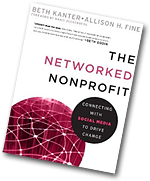 I’ve learned that you can never go wrong by going to a Beth Kanter panel. The co-author ofThe Networked Nonprofit (I’m halfway through it on my iPad, and it’s terrific) has a gift for bringing out the audience’s shared wisdom and experience while keeping the panel conversation lively and valuable.
I’ve learned that you can never go wrong by going to a Beth Kanter panel. The co-author ofThe Networked Nonprofit (I’m halfway through it on my iPad, and it’s terrific) has a gift for bringing out the audience’s shared wisdom and experience while keeping the panel conversation lively and valuable.
Not that panellists Danielle Brigida, social media outreach coordinator for the National Wildlife Federation, and Claire Williams, who leads social innovation at Twitter, needed any prodding. Each could have easily filled the hour with anecdotes, advice and recommendations. (Thanks to Williams, my new Twitter mantra is “WWKD: What Would Kanye Do?”)
Here are notes from Brigida’s and Williams’ presentations.
Baby needs a new premium template!
Originally posted on BlogWorld
I have learned that, apparently, no matter what your blog may be worth, the cashiers at the casinos here don’t accept it in lieu of tender. Hmph.
At a conference, “fresh” is relative
Originally published on BlogWorld
The one thing that cheers me up about the fact that there’s only a little more than an hour left in BlogWorld is this: the prospect of seeing sunlight again. Hearing the chirping of birds, the wind whispering on my cheek, the cursing of a driver who just got cut off on the Strip. Aaah.
That said, if I had to be indoors for three days, this was a pretty dang swanky place to do it in.
Swag!
Originally published on BlogWorld
I have a suitcase full of yo-yos, inflatable airplanes, T-shirts, USB drives and much more to take home with me tomorrow. What was your favourite piece of conference swag?
Besides, isn’t all video ‘mobile’? I mean, the pictures move.
Originally posted on BlogWorld
The day ended with a session on video, chaired by Susan Bratton of Personal Life Media, and featuring Dermot McCormack, Executive Vice President of MTV Music Group Digital; Dick Glover, CEO of Funny or Die; and Jim Louderback, CEO of Revision3.
There were some great moments, including the revelation that the budget of a typical Funny or Die video is… drumroll please… what’s that? We can’t afford a drumroll? That must be because the figure is only $2,000.
But the moment that grabbed me early on was the emphatic statement by one of the panelists that one huge factor affecting the future of video right now is the rise of mobile. And given how many conversations I’ve had with people who are still trying to get their minds around just how huge a platform mobile is, well, that spurred this cartoon.
Toonblog: Mark Penn and Karen Hughes on the state of digital politics
Originally posted on BlogWorld
For your consideration, notes from Karen Hughes’ and Mark Penn’s opening statements on the morning panel. It was a lively session (especially once some of that voter discontent started to bubble up from the floor!).
Toonblog: Darren Rowse on building community on your blog
Originally posted at BlogWorld
This one’s from a great session by Darren Rowse, co-author of Problogger, looking at building community on your blog. The ideas were coming far faster than I could capture them; I’ve tried to capture the highlights here.
Analyze this… repeatedly.
Originally published on ReadWriteWeb.
Google has just released a new feature for Analytics, replacing Site Overlay with In-Page Analytics.
And I think I have a terrific pitch for the media outlets that like to run huge social-media-is-killing-us-all headlines. Here’s how it goes:
When you’re playing Minesweeper, Solitaire or Angry Birds, it’s a little difficult to convince yourself that you’re being productive. But when you’re tinkering with Google Analytics, it’s a much easier sell.
And when Google comes along and makes Analytics that much more visual, then the combination becomes near-lethal. You can tweak away for hours, while one part of your brain is pumping out the isn’t-this-fun endorphins, and another is rationalizing that you’re doing something useful.
In other words, it’s only a matter of time before we hear the first reports of starvation deaths among Analytics users.
I am available for media interviews.
Toonblog: Mark Penn and Karen Hughes
Originally posted on BlogWorld.
For your consideration, notes from Karen Hughes’ and Mark Penn’s opening statements on the morning panel. It was a lively session (especially once some of that voter discontent started to bubble up from the floor!).
I set my politics aside while I drew this. It. Wasn’t. Easy.
Toonblog: Behind the wristband with Doug Ulman and Rohit Bhargava
It was an emotional and fascinating hour, starting with Rohit Bhargava‘s call for everyone in the audience whose lives had been touched by cancer to stand. Livestrong CEO Doug Ulman touched on how Twitter can sometimes be less daunting than blogging, how transparency and authenticity are transforming non-profits, when a logo can take away from an organization’s efforts, and why Livestrong focuses more on supporting families living with cancer than on research.
And it ended with the announcement that PayPal and Swagg would sponsor a 5-cent-per-tag bounty for every use of the hashtag #beatcancer for 24 hours – plus a $1 contribution for every pledge to download Swagg’s free iPhone app when it’s released. See BeatCancerEverywhere.com for details.
Toonblog: Darren Rowse on building your blog’s community
Originally posted on BlogWorld.
This one’s from a great session by Darren Rowse, co-author of Problogger, looking at building community on your blog. The ideas were coming far faster than I could draw them; I’ve tried to capture the highlights here.
That’s not why they call it a “blog feed”
Originally posted on BlogWorld.
Chris Garrett wrapped a bang-up presentation on creating killer content a little while ago, and one of his slides jumped out at me. It was a good slide, even a great slide… but I thought it could use just…a little…extra.
(My belief that almost nobody cares what you just ate has been magnified for the purposes of this drawing, actually. It all depends on what you’re aiming to do with your blogging.)
Watercooler 2010
Originally posted on BlogWorld.
The full title of this session was “Convergence of media and the future of unscripted drama on the web.” Brian Solis (author of Engage and creator of the Conversation Prism infographic you’ve used in at least three slide decks so far this year) interviewed Survivor creator Mark Burnett on how networked communication is challenging, supporting and transforming shows like his.
It was a fascinating conversation, starting with the essential importance of story to both blogging (something Solis speaks about so eloquently that I wonder if he might have the same kind of spec screenplays buried on his hard drive that I do) and shows like Survivor, where Burnett invoked Joseph Campbell and walked us through the show’s imagery of life, death and rebirth.
From there, the two looked at the way the online backchannel has transformed water-cooler conversations. Those conversations now start during the show itself, and take place everywhere, Burnett said. “The water cooler is now omni-present.”

The conversation ranged over football legend Jimmy Johnson’s appearance on a rescheduledSurvivor to the MTV Movie Awards, before they launched into Burnett’s latest project, Sarah Palin’s Alaska. He described Alaska as “epic”, and we became the first audience to see promotional footage from the upcoming show.
Then, at the end, Solis announced a surprise: the footage was being released to the world not through the usual channels, but via Steve Garfield’s YouTube channel. (Burnett acknowledged the plan may have initially caused some agita in the executive suites at TLC.)
BlogWorld Toonblog: Opening keynote – Scott Stratten and UnMarketing
Originally posted on BlogWorld.
It was a wildly energetic start to the morning from Scott Stratten, author of UnMarketing. He’s a terrifically visual speaker – which was mighty appreciated while I was drawing this!

